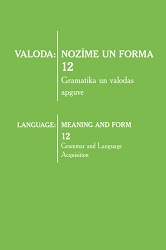Gramatikas mācību satura variācijas pamatizglītības posmā: latviešu valodas standartu analīze (1992–2018)
Variations of grammar learning content at elementary school: Analysis of Latvian Language Standards (1992–2018)
Author(s): Diāna Laiveniece, Linda LauzeSubject(s): Morphology, Syntax, Language acquisition, Baltic Languages, School education
Published by: Latvijas Universitātes Akadēmiskais apgāds
Keywords: Latvian language; grammar; basic education standard; Latvian learning content; morphology; syntax;
Summary/Abstract: Three basic education standards with different content of the Latvian language have been developed in Latvia between 1992 and 2018. The aim of the research is to analyse the proportion of grammar issues in these documents to evaluate the compliance of grammar learning content with learning outcomes. The following research methods have been used – descriptive analysis of documents, the excerpting of the text of Latvian language standards, comparative analysis of grammar learning content, and direct observations. The paper consists of three parts. First, the understanding of the concept of grammar is described. Then an overview of the development of Latvian language basic education standards is given. The third part analyses the content of grammar and its role in the development of language competence. It is important for Latvian language teachers to understand what the child uses unconsciously from the grammar of the mother tongue, and what must be learned consciously. It can be concluded that the proportion of grammar issues in the content of Latvian language teaching has decreased compared to the 1992 document, where more than half of the content of the eight themes is devoted to grammar issues because accents have been changed. The 2004 standard has an important communicative competence, the 2018 standard – the pragmatic aspect of language use and language creativity. In modern linguodidactics, grammar learning takes place in a definite context – speech situation, text – rather than in isolation, as has been the practice of learning Latvian as a mother tongue for more than a century (mainly in the 20th century), when text was only a means of identifying grammatical structures. The use of language is inconceivable without language competence based on grammar.
Journal: Valoda: nozīme un forma
- Issue Year: 2021
- Issue No: 12
- Page Range: 93-111
- Page Count: 19
- Language: Latvian

